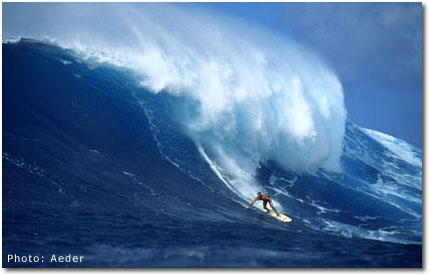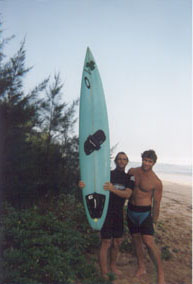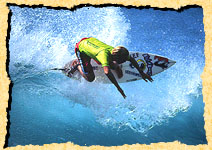

The air is brisk and clean bringing a slight chill in the early morning hours as a light wind blows through the valley. The foliage, still wet with early morning dew, covers both sides of the narrow country road with a thick blanket of emerald green that traverse up the high Maui mountain range. We reach the highway and it is not long before we turn into the fields, and begin the twisty winding journey to the edge of the cliff. We finally reach the lookout spot and Dave Kalama points out his beloved "Jaws".
A hundred feet below is Pe'ahi, so calm and serene it's almost impossible to believe that some of the biggest waves in the world are ridden here. It is clearly visible where the ledge drops off from shallow to deep by the change from a light to an almost eerie dark blue. This is where the huge ocean swells, traveling from thousands of miles away, rear their mighty heads and crash down in a tremendous display of power. This is it, where it all happens.
Rush Randle once told me about an elderly Hawaiian gentleman that they knew who told them that Pe'ahi meant "Fan, or fan shaped." If you look from the cliff, the trail of whitewater left by the wave is in the shape of a fan. Yet most people know the spot strictly as "Jaws." Some assume that it is best that it hold two names, one bestowed upon it by the ancient Hawaiians to distinguish its geographic location and beauty, and the other given to remind us of its awesome power and danger.
Throughout history, man has continually challenged the unknown in nature, often under heavy opposition and scrutiny from society, as they chose to put themselves in the face of danger. Often the conquering of these unknown forces and wonders of nature led to incredible advancements and exciting new ideas that helped to shape the world in which we live. Without Christopher Columbus's challenge that the world was round, ocean bound vessels would still fear the horizon. If not for the intuition of the Wright brothers, flight might still be a daydream in a young child's imagination, and if not for the genius of innovative scientists, Armstrong may have never set foot on the moon.
The surfing world has its own quest, the 'tow-in' movement. Defying the laws of gravity and physics, a few individuals are chasing waves that man has only viewed as Mother Nature's art, admiring it only from a distance. In turn they have become one with the picture and now add to the aesthetic beauty, hints of fear and awe as we watch the picture come to life.

The founders of this movement are a tight knit group of friends. Laird Hamilton, Dave Kalama, Brett Lickle, Rush Randle, Mark Angulo, Darrick Doerner, Mike Waltze, Buzzy Kerbox, and Pete Cabrihna are conquering waves that most fear, allowing the surfing world to explore an unexplored realm through their eyes. With the aid of Yamaha Wave Runners they are towing into some of the biggest waves ever surfed. Most are considered to be world class wind surfers, Dave Kalama, Rush Randle and Mark Angulo have been in the top ranks for years, but all are revered as remarkable watermen. Dubbed the 'tow-in brigade' by the media, they have taken big wave surfing to a level that has yet to be seen since Greg Noll's historic charge of 1969 or Brock Little's heroic take off at the 1990 Aikau. Shots of them conquering monstrous surf have graced the pages of surf magazines and industry advertisements world wide, and although the names and faces vary between the nine of them, all the captions have one thing in common: "Jaws".
All the captivating beauty and philosophical meaning aside, "Jaws" is about as dangerous and deadly as mother nature can get. I remember sitting in Dave Kalama's living room high up in Haiku, enjoying dinner and reminiscing about the days fun filled activities of surfing, golfing and getting beaten at beach volleyball. Whether it was fatigue or a momentary block of sanity, I asked Dave if he was ready to "play around" at Jaws this winter. His eyes were focused on the football game. After setting his plate down gently he turned to me and stared for a moment as if choosing his words carefully. After what seemed like eternity he calmly stated, "There is no such thing as playing out there- it's life or death," and continued dinner.
For weeks after that I pondered on those very words. What do you call a place where there is so much water churning around it feels like you are literally in a washing machine. A place where the boils are so big that they can swallow you up and never return you to the surface. A place where going over the falls means dealing with a force of water falling on top of you that is so tremendous and powerful it could break even the strongest man. A place where the white water in the impact zone is so high it hampers visual contact with your partner and the incoming sets, and so thick you have to clear it away to breath once you reach the surface. It's not their playground and I wouldn't even go as far as calling it their proving ground, its a "special place." A place made by God for men whose abilities as watermen surpass all others. Where simplicity is thrown out the window, and ability, strength, courage, and knowledge all come into play for survival.
The entire thing sort of jumped out at the public. One day the surfing world is continuing on its path of free-surfing progression and new school ideology, then the next day people are looking at pictures of Laird Hamilton carving on giant waves that throw out so far nobody can figure where it is. This wasn't the case for the "tow-in brigade" the development and evolution of "tow-in" surfing was slow and tedious. It had been experimented with and worked on for quite some time, and it was anything but an overnight love affair. They had worked together as a team to develop faster, smaller, and heavier boards. They had mastered the art of operating and modifying their personal watercraft in and around the high surf, as well as the art of "whipping" each other into waves, complete with hand signals and rules. Dave Kalama recollects, "Well, it was pretty much a combined effort. While Laird, and Darrick and Buzzy where towing in at big Backyards with conventional guns, Rush Randle, Mark Angulo, Brett Lickle and I were paddle surfing with straps on our boards on Maui. When we combined the two aspects that is when the evolution of tow surfing began, and led to where we are today." That evolution has been a driving force that has taken them bigger and deeper and at more risk than anyone could have imagined. As the stakes get higher, the team continues to modify their most important aspect on a regular basis - safety.
Safety is one of the primary issues that consistently badger the Maui crew; its not brought on by the public, but by themselves. They are constantly trying to increase the level of safety to ensure that everyone who leaves returns home to friends and family safely. All are certified in CPR, Lifesaving, and First Aid. They knew that to increase the level of safety they had to reduce the level of risk. They even called in "Mr. Risk Technician" himself, Brian Keaulana, who immediately became hooked on the place and joins them every chance he gets. "They (the Maui crew) act as a single unit, a team," says Brian. "It wasn't hard working with them because they had everything wired. All I did was fine-tune some aspects they already had going, and at the same time I learned a great deal. It was a sort of trade off. Both sides took turns being teacher and student. I'm honored to be involved". Their skis are armed with all sorts of devices in the event an emergency arises. They all carry knives (in case a rope needs to be cut), fins, walkie talkies, inflatable life vests, all have sleds on the back of their skis, and a boat is equipped with an oxygen unit and neck collars. "If you look back at every article and interview that has ever been written on us, you will see that our main concern is safety," says Dave Kalama. "Safety in tow-in surfing is being able to see a situation before it even arises. Using split second judgement and decisions based on knowledge, that's what it's all about when it comes down to it."
Many say that using the jet skis to tow into waves is cheating, and strays away from the true aspect of surfing. There are some who say it is way to dangerous, some condemn it for their own personal reasons, some who see it as a path of monetary gain, and even some who say they founded the sport. The controversy and scrutiny surrounding them is relentless, but is it justified? In reality a few men have chosen to take their gift as watermen, and transform it into an entity of surfing that defies all limits. They aren't disturbing anyone, as Pe'ahi is in a secluded bay surrounded entirely by high cliffs and ocean. The only lives they are endangering are their own. And if it is their quest to combine their knowledge and skills and defy Mother Nature, men have been doing it for centuries.
Whether the negative is a projection of jealousy, envy, anger or fear, it doesn't really matter to the Maui crew. They love the challenge, and that love mixed with a thousand PSI of adrenaline flowing through their veins keeps their movement going. Winter is upon us and it is impossible to predict what the Pacific will throw at them. Whether we agree or disagree with what they are doing is not the issue. What is important is what remains to be seen from this elite group of watermen in the years to come. What we can foresee is a new and exciting entity of surfing progressing continuously. Like Dave says, "After all, once you let go of the rope it's all about surfing."

 Home
Home